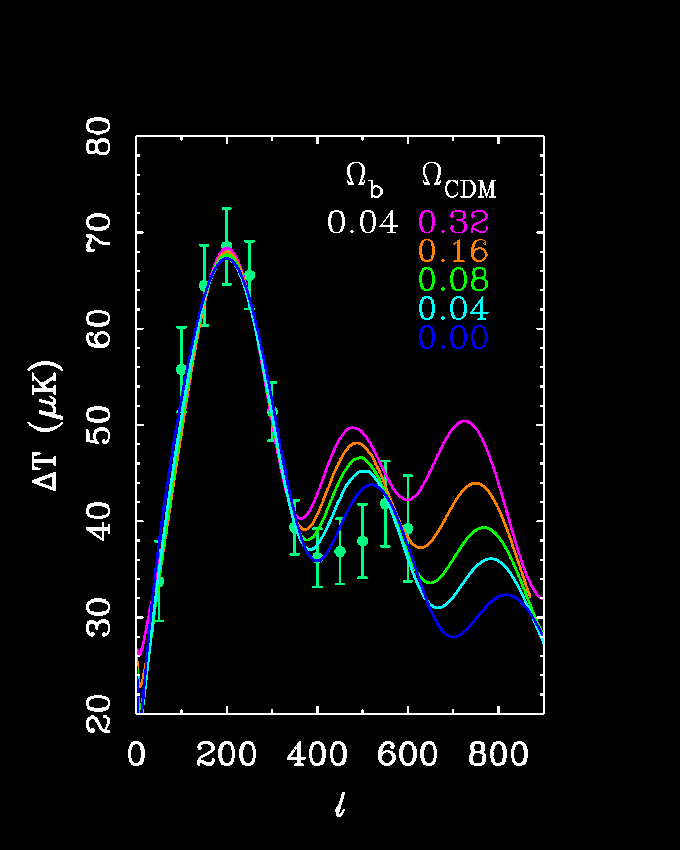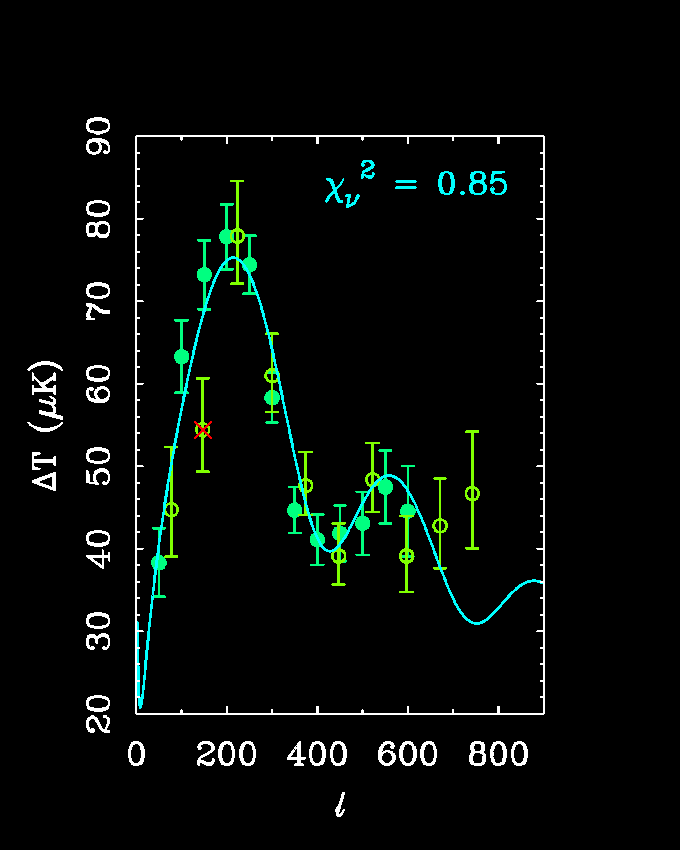Microwave Backround Experiments Confirm MOND Prediction
 The a priori predictions of (a) Lambda CDM and (b) purely
baryonic (MOND) models for plausible baryon densities
plotted against the BOOMERanG data (de Bernardis et al. 2000, Nature, 404, 955).
These models were published BEFORE the data
McGaugh (1999).
Though you will never see models like those in (a) ever again,
the large second peak was a very generic prediction of Lambda CDM
prior to the data. This was not observed. Instead,
the data are consistent with a purely baryonic universe devoid of CDM.
The model with Omega(baryon) = 0.03 fits the data very well with
X2 = 0.6
(McGaugh 2000).
The a priori predictions of (a) Lambda CDM and (b) purely
baryonic (MOND) models for plausible baryon densities
plotted against the BOOMERanG data (de Bernardis et al. 2000, Nature, 404, 955).
These models were published BEFORE the data
McGaugh (1999).
Though you will never see models like those in (a) ever again,
the large second peak was a very generic prediction of Lambda CDM
prior to the data. This was not observed. Instead,
the data are consistent with a purely baryonic universe devoid of CDM.
The model with Omega(baryon) = 0.03 fits the data very well with
X2 = 0.6
(McGaugh 2000).
This result lends strong support to the results from rotation curves
which indicate that a modification of basic dynamical laws, rather than dark
matter, is the explanation of the observed mass discrepancies.
WHAT? No Dark Matter??
 I find your lack of faith disturbing.
I find your lack of faith disturbing.
So what is going on here?
 This graph illustrates the effect on the microwave background power spectrum
of decreasing the CDM content of the universe while holding the
baryon-to-photon ratio and the geometry constant. As the mass in CDM decreases,
baryonic drag becomes more effective and damps the amplitude of peaks subsequent
to the first.
This graph illustrates the effect on the microwave background power spectrum
of decreasing the CDM content of the universe while holding the
baryon-to-photon ratio and the geometry constant. As the mass in CDM decreases,
baryonic drag becomes more effective and damps the amplitude of peaks subsequent
to the first.
Note that CDM models require Omega(CDM) > 0.16 to match large scale structure.
Maxima-1
 After the prediction for a zero-CDM MOND universe was made,
the BOOMERanG data appeared. So I wrote and submitted the paper
(McGaugh 2000).
While that was in the works, the Maxima-1 data appeared. These data extend
to slightly smaller angular scale (larger l). At first glance, these data
may appear inconsistent with the simple model. But in fact, they only degrade
X2 a bit to 0.85. The point which really hurts any model in
terms of X2 is the one at l=147. Since this is inconsistent with
the BOOMERanG data and any model, I have ignored it here.
After the prediction for a zero-CDM MOND universe was made,
the BOOMERanG data appeared. So I wrote and submitted the paper
(McGaugh 2000).
While that was in the works, the Maxima-1 data appeared. These data extend
to slightly smaller angular scale (larger l). At first glance, these data
may appear inconsistent with the simple model. But in fact, they only degrade
X2 a bit to 0.85. The point which really hurts any model in
terms of X2 is the one at l=147. Since this is inconsistent with
the BOOMERanG data and any model, I have ignored it here.
The reason the Maxima-1 point at large l does not seriously hurt
the statistical quality of the fit is that we've added a lot more data
points without a lot more free parameters. The fit to the BOOMERanG
data is shown, for which there were 2 free parameters: the amplitude dT and
the position of the first peak (the precise values of which are arbitrary
quantities for the test posed here, which depends only on the shape of
the spectrum.) The BOOMERanG and Maxima-1 data have a noticeable calibration
offset. That has been reconciled here by treating this offset in dT as a
third parameter, with the result that the BOOMERanG data have been scaled up
by 13.5% in order to match the Maxima-1 data.
My MOND-motivated, purely baryonic model is the only
a priori prediction which matches the observed
shape of the angular power spectrum of the microwave background.
- SSM, 10/00
 Return to the MOND pages home page
Return to the MOND pages home page
 "One day this war's gonna end"
"One day this war's gonna end"


 I find your lack of faith disturbing.
I find your lack of faith disturbing.


 Return to the MOND pages home page
Return to the MOND pages home page
 "One day this war's gonna end"
"One day this war's gonna end"